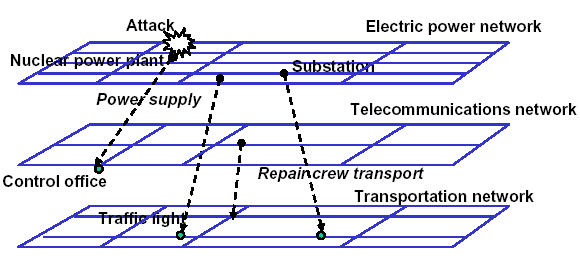
Considerable work has been carried out in recent years on vulnerability assessment of Critical Infrastructure Systems (CIS). Recent man-introduced hazard, including the 9/11 terrorist attack on the World Trade Center (WTC) in New York highlighted critical need to assess and evaluate the vulnerably of CIS with a focus on providing well coordinated and integrated strategies for public safety and property protection. One can generally group likely attacks, based on their source, into three categories: (1) physical attack, such as that of 9/11 that resulted in the collapse of the WTC, (2) biological, chemical and radiological attacks, and (3) cyber attacks. Most of the recent developments focused primarily on individual infrastructure assets, such as nuclear power plants, bridges, etc. This paper, however, addresses the interdependencies among those critical and vulnerable CIS vis-à-vis the cascading effects that may result as a consequence of natural or man-made disasters in one or more of the CIS network. The paper describes a framework that accounts for and assists in: (1) Identifying of critical components in interdependent urban CIS based on reliability assessment; (2) Modeling the cascading effects of a disaster in an urban CIS; and (3) Developing a decision support system (DSS) for prioritizing disaster mitigation and response strategies. In this framework a CIS network consists of a set of critical nodes, each representing a CIS. The nodes are connected with a set of links, each representing the logical relationship and strength that describe the impact of damage or malfunction associated with the preceding node on that of the succeeding node; capturing the cascading effect through the network being examined. The paper also highlights necessary methods and decision support tools required to perform the individual tasks as well as the implementation environment of the proposed methodology.
